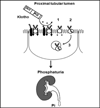Klotho and kidney disease
- PMID: 21170871
- PMCID: PMC3227531
Klotho and kidney disease
Abstract
Klotho is a single-pass transmembrane protein that exerts its biological functions through multiple modes. Membrane-bound Klotho acts as coreceptor for the major phosphatonin fibroblast growth factor-23 (FGF23), while soluble Klotho functions as an endocrine substance. In addition to in the distal nephron where it is abundantly expressed, Klotho is present in the proximal tubule lumen where it inhibits renal Pi excretion by modulating Na-coupled Pi transporters via enzymatic glycan modification of the transporter proteins - an effect completely independent of its role as the FGF23 coreceptor. Acute kidney injury (AKI) and chronic kidney disease (CKD) are states of systemic Klotho deficiency, making Klotho a very sensitive biomarker of impaired renal function. In addition to its role as a marker, Klotho also plays pathogenic roles in renal disease. Klotho deficiency exacerbates decreases in, while Klotho repletion or excess preserves, glomerular filtration rate in both AKI and CKD. Soft tissue calcification, and especially vascular calcification, is a dire complication in CKD, associated with high mortality. Klotho protects against soft tissue calcification via at least 3 mechanisms: phosphaturia, preservation of renal function and a direct effect on vascular smooth muscle cells by inhibiting phosphate uptake and dedifferentiation. In summary, Klotho is a critical molecule in a wide variety of renal diseases and bears great potential as a diagnostic and prognostic biomarker as well as for therapeutic replacement therapy.
Conflict of interest statement
Conflict of interest statement: None declared.
Figures





References
-
- Kuro-o M, Matsumura Y, Aizawa H, et al. Mutation of the mouse klotho gene leads to a syndrome resembling ageing. Nature. 1997;390:45–51. - PubMed
-
- Shiraki-Iida T, Aizawa H, Matsumura Y, et al. Structure of the mouse klotho gene and its two transcripts encoding membrane and secreted protein. FEBS Lett. 1998;424:6–10. - PubMed
-
- Matsumura Y, Aizawa H, Shiraki-Iida T, et al. Identification of the human klotho gene and its two transcripts encoding membrane and secreted klotho protein. Biochem Biophys Res Commun. 1998;242:626–630. - PubMed
Publication types
MeSH terms
Substances
Grants and funding
- R01 DK041612/DK/NIDDK NIH HHS/United States
- R01 AG019712/AG/NIA NIH HHS/United States
- R01 DK048482/DK/NIDDK NIH HHS/United States
- R01 DK091392/DK/NIDDK NIH HHS/United States
- P01 DK020543/DK/NIDDK NIH HHS/United States
- R01 AG025326/AG/NIA NIH HHS/United States
- DK41612/DK/NIDDK NIH HHS/United States
- R01 DK092461/DK/NIDDK NIH HHS/United States
- AG25326/AG/NIA NIH HHS/United States
- AG19712/AG/NIA NIH HHS/United States
- DK20543/DK/NIDDK NIH HHS/United States
- DK081523/DK/NIDDK NIH HHS/United States
- DK067158/DK/NIDDK NIH HHS/United States
- R01 DK081523/DK/NIDDK NIH HHS/United States
- DK081423/DK/NIDDK NIH HHS/United States
- P30 DK079328/DK/NIDDK NIH HHS/United States
- R01 DK067158/DK/NIDDK NIH HHS/United States
- R01 DK081423/DK/NIDDK NIH HHS/United States
- DK-079328/DK/NIDDK NIH HHS/United States
LinkOut - more resources
Full Text Sources
Other Literature Sources
Medical
Research Materials
Miscellaneous
